 By Bob Currie, Recreational Boating Safety Specialist
By Bob Currie, Recreational Boating Safety Specialist
U. S. Coast Guard Auxiliary Station Galveston Flotilla
Actors Morgan Freeman and Jack Nicholson had a very successful movie about creating a list of things they wanted to see and do before they died. The list of things to do was called a bucket list, as in the term “kicking the bucket.” This column is about an actual bucket that you fill with items that could be needed out on the water.
The Station Galveston Flotilla of the US Coast Guard Auxiliary operates out of the USCG Station Galveston base on Galveston Island. They aid the Coast Guard by providing maritime observation patrols in Galveston Bay; by providing recreational boating vessel safety checks; and by working alongside Coast Guard members in maritime accident investigation, small boat training, providing a safety zone, Aids to Navigation verification, in the galley, and watch standing.
Five Gallon Bucket with Lid
The primary purpose of the five gallon bucket is storage of important safety items and tools. The secondary purpose is to use as a dewatering device to bail water out of the boat. If there is continued leakage into the boat, then size matters. Be sure to get a bucket with a secure lid. The best type of lid is a gamma seal lid, which twists on and off (see below).
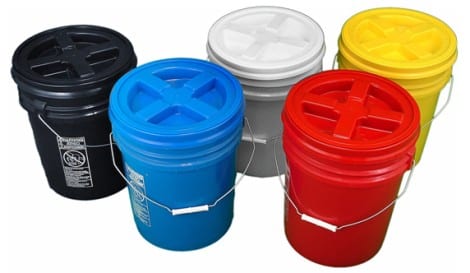
That type of lid provides a secure seal that won’t pop open if you drop the bucket. Lastly, in a pinch the bucket can serve as a toilet.
Dry Bag (20L)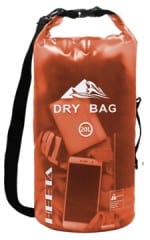
You will need a 20 liter dry bag to place inside your bucket. All the following items should fit nicely inside the dry bag. Buckets are not necessarily water-proof, but a dry bag is water-proof. You could store your bucket list items inside the bucket without a dry bag, but if you ever need to use the bucket to bail water from your boat then you will appreciate being able to simply lift all of the bucket list items out quickly without spilling them on your deck. Why 20 liters? That volume is as close to five gallons as you can get.
First Aid Kit
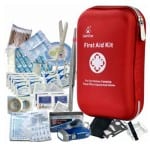 The compact first aid kit here costs less than $20.00 yet has quite an assortment of first aid items. Its small size will allow it to fit nicely in the dry bag and the bucket. The soft case makes it easier to manipulate and squeeze into the hard-sided bucket. First aid kits with hard cases can take up more room because they are not scrunchable.
The compact first aid kit here costs less than $20.00 yet has quite an assortment of first aid items. Its small size will allow it to fit nicely in the dry bag and the bucket. The soft case makes it easier to manipulate and squeeze into the hard-sided bucket. First aid kits with hard cases can take up more room because they are not scrunchable.
Visual Distress Signals
Just about every boat on the water is required to carry both day and nighttime visual distress signals. The best place to store visual distress signals is in a dry bag, but be sure to keep them close to the top of the dry bag for quick retrieval if needed. With space being a concern, the easiest visual distress signals to store in your bucket are the handheld day/night flares. The regulation requires that you have a minimum of 3, but they usually come in a pack of four. Be sure to watch your expiration date, as they are good for only 42 months from date of manufacture. Other signals you might include are the electronic SOS torch and the pistol-fired rockets. If you use the electronic torch, be sure to include the daytime flag in your bucket. It is that orange flag that comes with the torch.

Spare Kill Switch Lanyard
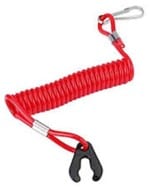 If you as the boat operator are using your kill switch lanyard as required by Texas law, if you suddenly end up in the water your boat engine will die instead of running out to sea or upon the beach or even running over you. But that leaves your boat some distance from you, and you have the lanyard required to get the boat started again. So, a prudent boater has a spare lanyard so that the boat can be started again and one of your passengers can motor to you and pick you up. Put it in a Ziploc bag so that it doesn’t get tangled up with other items, and also have it close to the top of the dry bag.
If you as the boat operator are using your kill switch lanyard as required by Texas law, if you suddenly end up in the water your boat engine will die instead of running out to sea or upon the beach or even running over you. But that leaves your boat some distance from you, and you have the lanyard required to get the boat started again. So, a prudent boater has a spare lanyard so that the boat can be started again and one of your passengers can motor to you and pick you up. Put it in a Ziploc bag so that it doesn’t get tangled up with other items, and also have it close to the top of the dry bag.
Spare Sound Producing Device
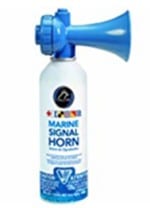 A horn. We are talking about a horn. A whistle will work to meet the minimum requirement, but do you really want to be a minimalist when your life is at stake? Get a small air horn and put it in your bag. That’s what other boaters will hear. You can get by with a whistle, but an air horn will provide you with a louder signal and if you are using it in the fog, you are less likely to be run over if you follow the Rules of the Road and sound the signal as required.
A horn. We are talking about a horn. A whistle will work to meet the minimum requirement, but do you really want to be a minimalist when your life is at stake? Get a small air horn and put it in your bag. That’s what other boaters will hear. You can get by with a whistle, but an air horn will provide you with a louder signal and if you are using it in the fog, you are less likely to be run over if you follow the Rules of the Road and sound the signal as required.
Tool Bag
You can buy a bag and customize the contents, or you can purchase a kit with all sorts of tools inside. You don’t need a large bag, but a soft sided canvas tool bag is better than a hard case. If you add your own list of tools, here is a list for consideration:
- Flashlight and batteries
- Spark plug wrench and spare spark plugs
- Assortment of fuses (depends on your boat’s needs)
- Allen wrench set
- Box wrenches and socket set (SAE or metric as needed)
- Hacksaw, utility knife, and scissors
- Assortment of screwdrivers
- Vice grip pliers and electrical connection crimper
- Tie straps and small roll of wire
- Safety glasses
- WD40 or machine oil
- Hammer/hatchet combination
- Utility rag
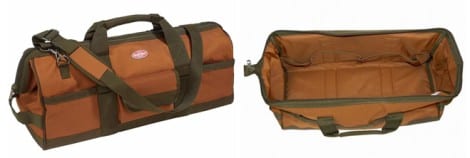
Roll of Toilet Paper
Because, you know. If your space in the bucket is tight, wait until that roll in your bathroom at home is half the diameter of a new roll and put that in your bucket. Smash it down and put it in a Ziploc bag also. I don’t think we need a picture here.
Duct Tape
All you McGyvers out there know how important this item is. Duct tape can be used to patch up either you or something on your boat. I was 100 miles out fishing when the rocking of the boat caused a snapper hook to rip through the palm of my hand. Oh, it’s a neat looking scar. One wrap around my hand with some duct tape and some hydrogen peroxide and we kept fishing. Not the best practice of medicine, but it sure got me back to shore without bleeding out. No infection either.
Make a List of Items in Your Bucket
Finally, create a list of items included in your bucket and keep it on top of the dry bag. That list can save you a lot of searching for a particular item if it isn’t even included in your bucket list.
Summary
If there is anything every boat owner wishes for, it is a larger boat. You can make your boat seem bigger by using your storage space wisely and storing things out of the way yet easy to get to as well as easy to remember where they are located. A five-gallon bucket, useful by itself, can be used to store quite an array of safety and convenience items. If the bucket won’t fit inside a storage locker, find a good place on the boat and use some bungee cords or another method to secure the bucket.
For more information on boating safety, please visit the Official Website of the U.S. Coast Guard’s Boating Safety Division at www.uscgboating.org. Questions about the US Coast Guard Auxiliary or our free Vessel Safety Check program may be directed to me at [email protected]. SAFE BOATING!
[July-27-2020]

 Posted in
Posted in 
























